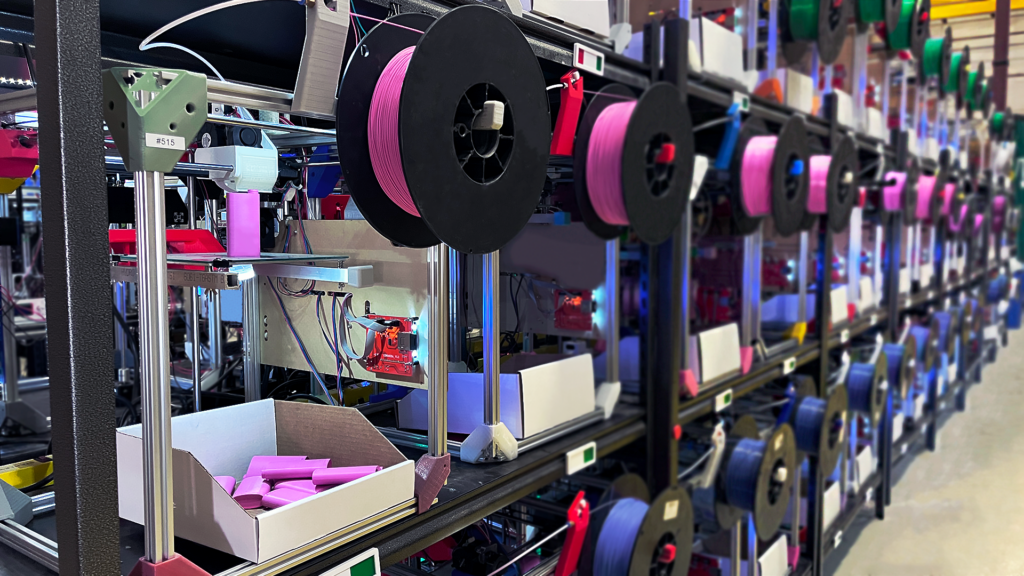Slant 3D, known for its 3D print farms comprising cost-effective material extrusion machines, has been a subject of our discussions since our interview with founder Gabe Bentz and an article about the company from 2017. Offering services as a print service provider or a scalable manufacturing partner, Slant 3D has recently advanced by launching an API. This API facilitates direct connection of your 3D printing production to your app or website, automating the processes of slicing, pricing, and printing files.
Now, developers, artists, or marketing professionals can establish a revenue stream through 3D printed products. For example, Sally could concentrate on developing and marketing a fun design tool for guitar picks, with Slant 3D handling the production side. This move parallels efforts by Materialise and Shapeways, but focuses on material extrusion, offering a cost-effective alternative to the more expensive powder bed fusion. Although material extrusion parts might not match the detail and definition of powder bed fusion parts, the wide variety of materials and colors available at a lower price point could enable the creation of a broader range of parts.
Now, you too can become a print farmer. You can simply send your files to Slant 3D and relax as the company does all of the hard work. While identifying profitable applications may present challenges, this development has the potential to unlock print farming niches and vast opportunities globally.
Historically, scaling up manufacturing has been a daunting and expensive task, fraught with logistical and technical challenges. However, Slant 3D’s API removes these obstacles, enabling large-scale production capabilities without necessitating significant upfront investments. Customers are only charged for the product after it’s manufactured, drastically reducing the barriers to entry for new and innovative products to enter the market.
“We’ve effectively put our factory on the cloud. Now, a kid in Africa with an Internet connection can design a product that someone in New York can purchase, all made possible through our API,” the company says.
The company offers a cloud-based slicer and efficient logistics, enabling them to fulfill orders within three to five days, accommodating up to a hundred thousand components per order. Although the API is still in Beta, interested parties can sign up for access.
An example of a product created using Slant’s capabilities is the Jointlocker, a case for a Bic lighter that includes a compartment for a joint. This product, designed by one individual and commercialized by a different company, is available at Urban Outfitters, retailing for $24. In a video, the company discusses how it redesigned the product for material extrusion, highlighting an innovative feature: an internal rib that securely holds the Bic lighter, whether empty or full, enhancing the user experience.
Perhaps the quest for complex, high-end products like aero engines and medical implants has led to an overcomplication of our lives. What if instead, we dedicated more time to creating consumer hit products? Imagine focusing on more enjoyable projects, spending extensive periods designing and experimenting with a variety of unique designs quickly to discover what might resonate. The advantage of the Slant API, and 3D printing in general, is its capacity to empower the development of a brand, website, and new product monthly. While not every endeavor may succeed, persistence could eventually lead to a breakthrough. Additionally, identifying a niche product that sells a modest quantity monthly could prove to be profitable over time, and it may open the door to discovering further niches.
The concept of print farms that produce their own filament particularly appeals to me. The notion of making low-cost parts accessible for a wide range of applications and industries is quite compelling.
I also really like the idea that Rajiv from his dorm room could make some kind of fidget spinner like global hit. Or perhaps he just makes a cool pen holder that for one weekend sells 1,000 copies in Tokyo? All the same, I really think we should have more print farms such as Slant, and I believe in the bright future of in a low friction way coupling an idea to a physical good in a scalable way.
Subscribe to Our Email Newsletter
Stay up-to-date on all the latest news from the 3D printing industry and receive information and offers from third party vendors.
You May Also Like
3D Printed Heat Spreader Could Improve Efficiency of Electronics
The low-hanging fruit for decarbonization has long been improving the efficiency of existing systems, hence the justification for LED lights and ENERGY STAR certified appliances. While such minor moves are...
3D Printing News Unpeeled: Marine Gearboxes, 3D Printed Motors and $1.7 Million in Seed Funding
UK based Equipmake just released their Ampere-220 e-axle system. The system, which is meant for high performance electric cars, was similar to one released on the Ariel HIPERCAR. It has...
CEAD Unveils 36-Meter-Long 3D Printer for Abu Dhabi’s Al Seer Marine
CEAD, a Dutch original equipment manufacturer dedicated to large-format 3D printers, has unveiled what it claims to be the world’s largest robotic arm-based 3D printer. At 36 meters long and...
3D Printed Biocomposites Could Help Reduce Marine Plastic Pollution
Concerns about the impact of plastic litter and microplastics in the oceans are at the forefront of environmental study. For decades, the marine environment has suffered from the degradation of...






































